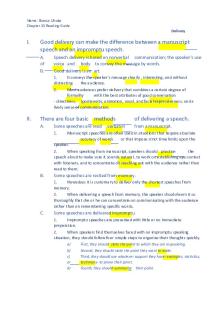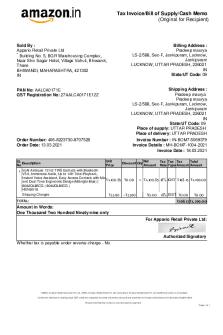Stats Modeling the World Reading Guides-Chapter 13 PDF

| Title | Stats Modeling the World Reading Guides-Chapter 13 |
|---|---|
| Author | Brandon Rutland |
| Course | Intro. Statistics Ii |
| Institution | Georgia Southern University |
| Pages | 3 |
| File Size | 187.6 KB |
| File Type | |
| Total Downloads | 107 |
| Total Views | 132 |
Summary
gewrtyuiopiugyfdtgyuihojpiufgihojpiuyfghk;gfdfxhkjhgmhxfgnhgcjhvkjblkbjkhvcgmxfndzgxcyviugligluhvadskh vliuqehliugwrlic jedc ,jehqbdc lihbvei hlibdlich lihqwelch lqh cluqeh clh elhq clire ciqe lvh eqqcjkh cs kj cluh clh eljh...
Description
Stats: Modeling the World - Bock, Velleman, & DeVeaux
Chapter 13: From Randomness to Probability Key Vocabulary:
probability trial outcome event
independent Law of Large Numbers complement disjoint
mutually exclusive
1. In statistics, what is meant by the term random?
Cannot predict the outcome, but the possible outcomes are known. 2. In statistics, what is meant by probability?
The chance that something will occur (numerical value) 3. What does it mean for trials to be independent?
The outcome of one trial is not dictating the outcome of another. 4. How is the Law of Large Numbers related to probability?
Probabilities settle around a single value with more trials, and relative frequencies get closer to the true frequency as you do more trials. 5. In statistics, what is an event?
Collection of outcomes of trials. 6. Explain why the probability of any event is a number between 0 and 1.
Values below zero would be less than the lowest possible chance of occurring and above 1 are above the highest chance of occurring. 7. What is the sum of the probabilities of all possible outcomes?
All possible outcomes should add up to 1 8. Describe the probability that an event does not occur?
1-P(event) = P(event) 9. What is meant by the complement of an event?
1-P(event) 10. When are two events considered disjoint?
No outcomes in-common, and if you were drawing a venn diagram, there would be no overlapping section. 11. What is the probability of two disjoint events?
Sum of the probabilities of the two events Chapter 13: From Randomness to Probability
Stats: Modeling the World - Bock, Velleman, & DeVeaux
12. What is the Multiplication Rule for independent events? P(AnB) = P(A) P(B)
Chapter 13: From Randomness to Probability
13. Can disjoint events be independent?
No 14. If two events A and B are independent, what must be true about Ac and Bc?
A’ and B’ are independent, A is independent of B 15. What is meant by the union of two or more events? Draw a diagram.
P(AuB) = P(A) or P(B)
16. State the addition rule for disjoint events.
P(AuB) = P (A) = P (B) 17. What is meant by the intersection of two or more events? Draw a diagram.
P(AnB) = P(A) AND P(B)
18. Explain the difference between the union and the intersection of two or more events. Union = or Any of these occur Intersection = and
All of these occur...
Similar Free PDFs

13 types of cities of the world
- 2 Pages

WS 13 (Modeling with Functions)
- 2 Pages

Chapter 13 Active Reading
- 8 Pages

Chapter 13 Reading Guide
- 4 Pages

Chapter 13 Guided Reading
- 5 Pages

Reading Notes for World Hunger
- 3 Pages

Ball World and the world
- 4 Pages

Chapter 13 - Summary World Art
- 3 Pages

CFA lvl 1 - Reading 13
- 1 Pages
Popular Institutions
- Tinajero National High School - Annex
- Politeknik Caltex Riau
- Yokohama City University
- SGT University
- University of Al-Qadisiyah
- Divine Word College of Vigan
- Techniek College Rotterdam
- Universidade de Santiago
- Universiti Teknologi MARA Cawangan Johor Kampus Pasir Gudang
- Poltekkes Kemenkes Yogyakarta
- Baguio City National High School
- Colegio san marcos
- preparatoria uno
- Centro de Bachillerato Tecnológico Industrial y de Servicios No. 107
- Dalian Maritime University
- Quang Trung Secondary School
- Colegio Tecnológico en Informática
- Corporación Regional de Educación Superior
- Grupo CEDVA
- Dar Al Uloom University
- Centro de Estudios Preuniversitarios de la Universidad Nacional de Ingeniería
- 上智大学
- Aakash International School, Nuna Majara
- San Felipe Neri Catholic School
- Kang Chiao International School - New Taipei City
- Misamis Occidental National High School
- Institución Educativa Escuela Normal Juan Ladrilleros
- Kolehiyo ng Pantukan
- Batanes State College
- Instituto Continental
- Sekolah Menengah Kejuruan Kesehatan Kaltara (Tarakan)
- Colegio de La Inmaculada Concepcion - Cebu






